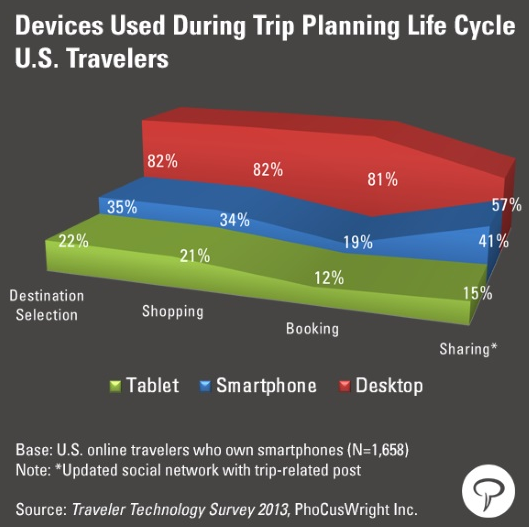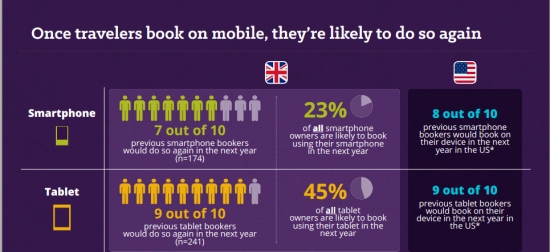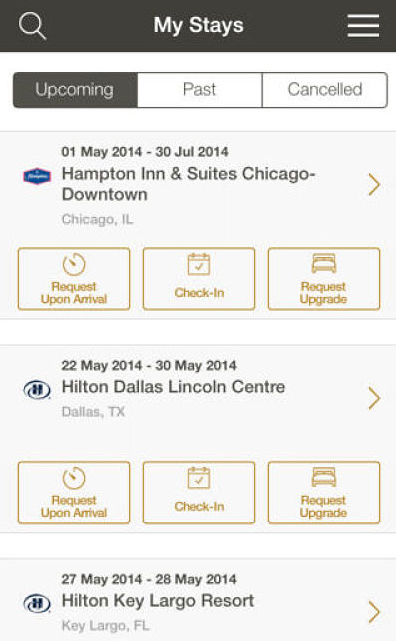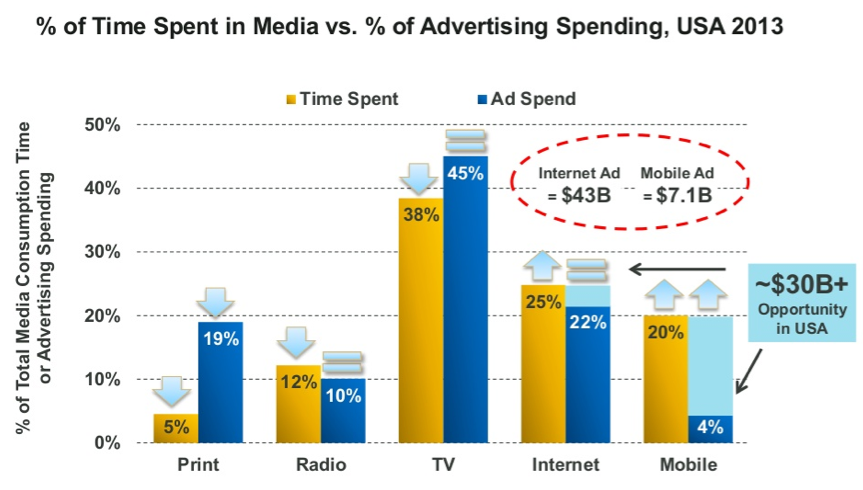This is the tenth in a series of “Best Practices in Travel” posts to be published on this blog. Today, we focus on mobile marketing!
Few industries have been more impacted by the ever-increasing adoption rates of mobile devices as the travel & hospitality industry. I mean, think about it: smartphones are particularly useful when you are on the move, and with the growing last-minute trend in travel bookings, it’s not uncommon to see people research for their accommodation on the same day of travel.
In fact, various studies showed more than 65% of mobile reservations for hotels were within 24 hours or arrival. But it’s not just about accommodation, with new applications such as FlightTonight now helping people finding last minute flight deals. Not to mention the countless applications that can help you find restaurants, attractions, or a variety or locally-based deals once at a destination.

Yeah, but nobody really books via smartphones, right? Wrong. First, it’s important to clarify that “mobile devices” include both smartphones AND tablets, with which users don’t necessarily have the same behavior according to the stage of their travel planning (see above).
Second, according to a recent emarketer report, 25% of online travel revenues will come from mobile devices in 2015 (this level is expected to be at 16% by the end of this year). And finally, as can be seen above from a recent PhoCusWright survey, mobile travelers also use their devices for destination selection, shopping and sharing their experiences.
It’s no surprise to see 41% of US travelers using smartphones to share their travel moments, knowing how intertwined mobile and social have become. Did you know for example that:
- Of the 1.3 billion active users on Facebook, more than one billion access the network from a mobile device. In fact, Facebook is the most popular app on both AppStore and GooglePlay, worldwide!
- 76% of actives users on Twitter access it through a mobile device;
- 75% of all Pinterest daily traffic comes through mobile applications. In fact, 35% of Pinterest unique visitors are mobile-only!
- 41% of LinkedIn’s traffic comes from mobile as well.
With these statistics in mind, and knowing that mobile is here to stay – and grow -, here are five best practices to consider.
1. MOBILE SITE
By the end of 2012, it was estimated that close to 25% of all online searches related to travel came from a mobile device. This figure had jumped to 40% by the end of 2013 and a recent survey by digital consultancy Nucleus predicts that the majority of searches will come from mobile devices early 2015.
In fact, luxury travel websites already have reached the 55% threshold from mobile devices, according to that same research. So if one out of every two web visits now comes from a mobile user, why are there still so very few mobile-optimized sites out there in the travel vertical?

With its latest Pigeon algorithm update, Google actually confirms that “modern sites” will rank higher in search, which means responsive sites that showcase content that adapts according to the screen of your device, i.e. desktop, smartphone, tablet, etc. Savvy travel brands will have already adapted their websites accordingly, with some even opting with mobile-first design.
But if your are a travel brand without any mobile offering, you are basically turning away half of all internet users…
2. MOBILE APP
Should your product or service have its own application? Long gone are the days where building mobile applications required complex design and costly programing. Almost anybody can know offer a mobile app, but this makes it even more difficult to be found by potential users.
Many destinations offer travelers the possibility to download an application to discover local specialties, attractions and restaurants, access festival & events calendars, maps, currencies or perhaps lesser-known neighborhoods.

Hotel chains, such as Hilton Hotels (see above screenshot) are embracing the mobile landscape and are using apps as customer loyalty tool, providing enhanced check-in experience, the possibility to choose a room on any given floor. And, starting in 2015, even using your own mobile device as a door key…
But before spending a dime of creating your own application, ask yourself the question: why would any traveler download this, amongst the million of other apps available? How will you scale it in time? Do you have dedicated budgets to promote its usage and to maintain it in time?
3. MOBILE OFFLINE
 One of the biggest challenges with mobile usage when traveling comes from those expensive roaming fees, specially if you are traveling outside of your own country or depending on your telecom plan.
One of the biggest challenges with mobile usage when traveling comes from those expensive roaming fees, specially if you are traveling outside of your own country or depending on your telecom plan.
And in some parts of the world, even here in North America, coverage can be somewhat limited and sometimes non-existent in remote areas. That’s why we’re seeing TripAdvisor and Google Maps now providing versions of their popular applications accessible offline, so that we can still use them.
TripAdvisor clearly highlights these benefits with its “City Guide” application, claiming : Traveling somewhere? Get this FREE city guide with the restaurants, attractions, hotels and reviews you love from TripAdvisor, stored in the app — no data roaming charges!
As for Google Maps, did you know this was the most popular application for American travelers? According to a recent study conducted by MMGY, 2014 Portrait of American Travelers, navigating with a GPS is the most popular activity on a smartphone, and it’s also the most popular type of mobile application downloaded!
So if you can provide a great mobile experience thinking “offline” for your customers, this can become a competitive advantage.
4. MOBILE MARKETING
While mobile is now widely recognized as a growing channel and communication tool with past, present and potential customers, marketers are not walking the talk when it comes to spending advertising budgets. Even though print is declining and represents only 5% of time spent in media, it gets a disproportionate 19% of advertising spending.
At the other end of the spectrum? Mobile, which now boasts 20% of our time spend in media, while only receiving 4% of advertising dollars. In fact, according to IAB figures reported in the most recent KPCB Internet Report 2014, there is a $30 billion gap, or opportunity, to invest on digital assets (internet + mobile) in the US alone.

Best practices for mobile marketing would include, and are not limited to:
- Promotional codes via SMS campaigns (text-messaging)
- QR codes within other digital outposts, i.e. newsletters, social media, website, etc.
- In-app offers and/or advertisement
- Facebook Ads or Promoted Posts, with a mobile-specific audience
- Mobile-optimized AdWords campaigns
5. SMARTPHONES VS TABLETS
Users don’t behave the same on smartphones and tablets, so how should your strategy adapt accordingly? We’re seeing online travel agencies provide a different application for iPad versus apps for smartphones (iOS or Android), for example. Take a look at the following stats regarding mobile visits on key online properties relevant to the travel industry.
Based on these findings, we may want to share photos with different sizes depending on our where our audience is more active, for example smaller photos for Pinterest (where most pins come from smartphones), while focusing on bigger visuals and videos for tablet users on Twitter and YouTube.
Responsive web design is great because it allows for a website’s content to adapt according to any device, but marketers must beware of treating the digital landscape as a “one-size-fits-all”. The experience is not the same, nor is our behavior, on these various devices.
Finally, take a look at this neat infographic summarizing well the mobile landscape in the US right now, and where you may want to shift some of your travel marketing digital efforts in coming months.











Leave a Reply